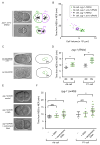Cell Size Determines the Strength of the Spindle Assembly Checkpoint during Embryonic Development
- PMID: 26859356
- PMCID: PMC4748171
- DOI: 10.1016/j.devcel.2016.01.003
Cell Size Determines the Strength of the Spindle Assembly Checkpoint during Embryonic Development
Abstract
The spindle assembly checkpoint (SAC) delays mitotic progression when chromosomes are not properly attached to microtubules of the mitotic spindle. Cells vary widely in the extent to which they delay mitotic progression upon SAC activation. To explore the mechanisms that determine checkpoint strength in different cells, we systematically measured the mitotic delay induced by microtubule disruption at different stages of embryogenesis in Caenorhabditis elegans. Strikingly, we observed a gradual increase in SAC strength after each round of division. Analysis of mutants that alter cell size or ploidy revealed that SAC strength is determined primarily by cell size and the number of kinetochores. These findings provide clear evidence in vivo that the kinetochore-to-cytoplasm ratio determines the strength of the SAC, providing new insights into why cells exhibit such large variations in their SAC responses.
Copyright © 2016 Elsevier Inc. All rights reserved.
Figures




Comment in
-
Bigger Isn't Always Better: Cell Size and the Spindle Assembly Checkpoint.Dev Cell. 2016 Feb 8;36(3):244-6. doi: 10.1016/j.devcel.2016.01.017. Dev Cell. 2016. PMID: 26859348
Similar articles
-
Bigger Isn't Always Better: Cell Size and the Spindle Assembly Checkpoint.Dev Cell. 2016 Feb 8;36(3):244-6. doi: 10.1016/j.devcel.2016.01.017. Dev Cell. 2016. PMID: 26859348
-
Acquisition of the spindle assembly checkpoint and its modulation by cell fate and cell size in a chordate embryo.Development. 2023 Jan 1;150(1):dev201145. doi: 10.1242/dev.201145. Epub 2023 Jan 5. Development. 2023. PMID: 36515557
-
NudE regulates dynein at kinetochores but is dispensable for other dynein functions in the C. elegans early embryo.J Cell Sci. 2018 Jan 8;131(1):jcs212159. doi: 10.1242/jcs.212159. J Cell Sci. 2018. PMID: 29192061 Free PMC article.
-
Connecting up and clearing out: how kinetochore attachment silences the spindle assembly checkpoint.Chromosoma. 2012 Oct;121(5):509-25. doi: 10.1007/s00412-012-0378-5. Epub 2012 Jul 11. Chromosoma. 2012. PMID: 22782189 Review.
-
Joined at the hip: kinetochores, microtubules, and spindle assembly checkpoint signaling.Trends Cell Biol. 2015 Jan;25(1):21-8. doi: 10.1016/j.tcb.2014.08.006. Epub 2014 Sep 11. Trends Cell Biol. 2015. PMID: 25220181 Review.
Cited by
-
Excessive Cell Growth Causes Cytoplasm Dilution And Contributes to Senescence.Cell. 2019 Feb 21;176(5):1083-1097.e18. doi: 10.1016/j.cell.2019.01.018. Epub 2019 Feb 7. Cell. 2019. PMID: 30739799 Free PMC article.
-
Cell polarity-dependent centrosome separation in the C. elegans embryo.J Cell Biol. 2019 Dec 2;218(12):4112-4126. doi: 10.1083/jcb.201902109. Epub 2019 Oct 23. J Cell Biol. 2019. PMID: 31645459 Free PMC article.
-
Principles and dynamics of spindle assembly checkpoint signalling.Nat Rev Mol Cell Biol. 2023 Aug;24(8):543-559. doi: 10.1038/s41580-023-00593-z. Epub 2023 Mar 24. Nat Rev Mol Cell Biol. 2023. PMID: 36964313 Review.
-
Spindle assembly checkpoint insensitivity allows meiosis-II despite chromosomal defects in aged eggs.EMBO Rep. 2023 Nov 6;24(11):e57227. doi: 10.15252/embr.202357227. Epub 2023 Oct 5. EMBO Rep. 2023. PMID: 37795949 Free PMC article.
-
An unexpected timer for cell division.Nature. 2023 May;617(7959):39-40. doi: 10.1038/d41586-023-01355-9. Nature. 2023. PMID: 37101067 No abstract available.
References
-
- Chao WC, Kulkarni K, Zhang Z, Kong EH, Barford D. Structure of the mitotic checkpoint complex. Nature. 2012;484:208–213. - PubMed
-
- Chen RH, Waters JC, Salmon ED, Murray AW. Association of spindle assembly checkpoint component XMAD2 with unattached kinetochores. Science. 1996;274:242–246. - PubMed
-
- Clute P, Masui Y. Regulation of the appearance of division asynchrony and microtubule-dependent chromosome cycles in Xenopus laevis embryos. Dev Biol. 1995;171:273–285. - PubMed

